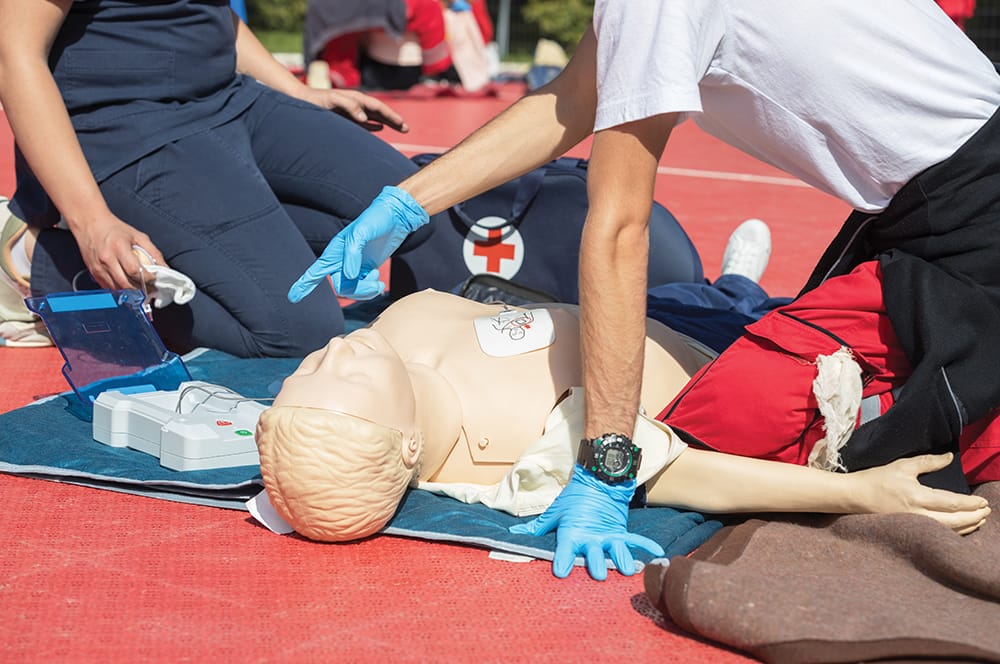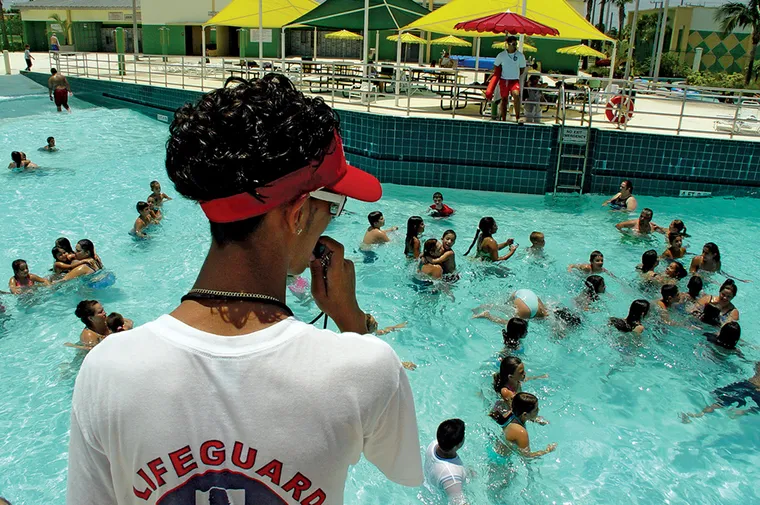Promoting patron safety and enjoyment in aquatic environments
By Eric Spacek
Despite the prevalence of swim-safety programs and classes, drowning remains a major risk for both adults and children.
In the United States, an average of 3,500 to 4,000 people drown each year—that translates roughly to 10 fatal drownings per day. And not all of these drownings are children—almost 40 million adults (15.4%) do not know how to swim, and more than half (54.7%) have never taken a swimming lesson.
Leaders who run aquatic facilities should take extra steps to protect patrons so they can have an enjoyable and safe experience every time they enter the water. There are some critical ways to do that.
Always Have Plenty Of Supervision
A trained lifeguard should be present whenever children or adults are in the water. But lifeguards are not enough—especially when children swim at a facility. Trained staff members—in addition to the lifeguards—should be available to assist swimmers and supervisors and provide oversight.
Young children should never be far from an adult who is actively watching them. A child or weak swimmer can drown in the time it takes for a supervising adult to return an email or grab a towel. While an adult may justify his or her absence by pointing to several other strong swimmers in the vicinity of the child, that is not a valid excuse. Other swimmers are not necessarily paying close attention to young children who are not in their care, and it only takes a moment for a child to slip out of sight.
While lifeguards and supervisors should, of course, be watching closely for any swimmers in distress, they are also responsible for enforcing safety rules. Horseplay, running, or other unsafe practices should not be permitted.
Screen Swimmers
One of the best ways to protect children in the water is by ensuring they stay in an area appropriate for their swimming ability.
Some insurance organizations offer swimming-safety materials to their customers. These materials include evaluations to determine swimmers’ skills, guidelines for lifeguards and supervisors, and color-coded wristbands that clearly show each swimmer’s level of ability.
The intention is for children to be tested immediately when entering the swimming area. The results of the test will determine which color wristband they receive:
- Red is for non-swimmers: This includes children under the age of 7 and those who are unable to demonstrate any basic skills. They should stay in wading areas.
- Yellow is for intermediate swimmers: Some children can submerge their heads underwater and perform a few basic strokes. But they cannot keep themselves afloat or swim for any sizable distance, which is why they should stay in areas where they can comfortably stand.
- Green is for qualified swimmers: These children can tread water, swim using several different strokes, float on their backs for a substantial amount of time, and easily enter and exit the water. They are strong swimmers, and while they still require lifeguard supervision, they should be allowed greater freedom.
Create A Written Policy
When it comes to risk management at a facility, good safety rules are important—and good documentation is even more important. There should be a written protocol that all staff members—not only lifeguards—can use to prevent drowning. This policy should include the following:
- Guidance about lifeguards: It should be clear how many lifeguards are required at any given time, and the rules to which lifeguards must adhere:
- Be free of all distractions, including cell phones and other screens.
- Scan the area of responsibility from bottom to top every 10 seconds.
- Recognize, respond, and rescue a distressed swimmer in less than 20 seconds.
- Apply pool rules to all swimmers.
- Supervision rules: Clearly post rules for all swimmers and adults to see. These include guidance about the age below which swimmers should have adult supervision, restrictions for certain areas of the facility, and information about where rescue equipment is located.
- Information about the buddy system: More important than always having a lifeguard available is requiring that swimmers always have a buddy with them. No one should ever swim alone in a facility, and the policy should reflect that rule. Make it clear, both in the policy and in signage at the facility, that swimming alone is unacceptable.
- Strategies that allow supervisors to account for all swimmers:
- Conducting regular headcounts at preplanned intervals
- Scanning the pool area for swimmers in distress
- Using elevated vantage points to improve visibility
- Communicating with all swimmers about how to report a missing person.
Ensure Appropriate Training And Certification For All Aquatic Staff
According to the American Red Cross, lifeguards should not only have comprehensive training in water rescue and first aid, but also be able to exhibit leadership, communication, and problem-solving skills. The Red Cross Lifeguarding course includes certifications in cardiopulmonary resuscitation (CPR) and automated external defibrillator (AED) use, as well as first aid.
Lifeguards and other aquatic staff members should be familiar with the five layers of drowning protection:
- Barriers and alarms: A swimming area should be protected on all sides to prevent children and unauthorized adults from accessing it without supervision.
- Supervision: Children should always have capable adult supervision from a lifeguard or a water watcher who is specifically watching for drowning risk.
- Water competency: Every child and adult should have the basic water-safety skills to protect themselves while in a swimming area.
- Life jackets: These flotation devices can protect both children and adults, particularly in open-water areas. All life jackets should be evaluated and approved by the United States Coast Guard.
- Emergency preparation: All staff members should be prepared for an emergency with basic water-rescue skills and knowledge of CPR. Make sure all rescue devices and a phone are easily accessible in case of an emergency.

Evaluate All Safety Equipment—Including Emergency Care
Safety equipment is vital in any water area, but it only works if it is operational, in usable condition, and easily accessible. What good is a shepherd’s crook or rescue pole if it falls apart while in use? If a lifeguard cannot locate a ring buoy and throw a line in a timely fashion, precious seconds lost can mean the difference between life and death for a swimmer.
The following safety equipment should be in top condition and close to a water area:
- Lifesaver rings: These are usually plastic, soft, and resilient to the touch. If lifesaver rings develop brittle edges, they should be replaced.
- Shepherd’s crooks or rescue poles: These safety life hooks are extended for a swimmer in distress to grab onto.
- Safety ropes: These allow lifeguards or other supervisors to reach a swimmer far away from the shore or deck without putting themselves in danger.
- Automated external defibrillator (AED): This medical device analyzes the heart’s rhythm and delivers an electrical shock to help restore a normal rhythm.
- First aid kit: Essential items include bandages, antibiotics, a CPR mask, plastic gloves, ear drops, eye drops, an emergency blanket, gauze, scissors, and a whistle.
Keep A Close Eye On Water Quality
While drowning is, of course, the primary safety concern in a swimming area, there are other risks—namely, water quality.
Pool quality: If a facility operates either an indoor or outdoor pool, officials should test the water regularly. To maintain good water quality, leaders must do the following:
- Use a pool test kit to measure the pH and chlorine levels.
- Balance the pH level so it is between 7.4 and 7.6. If required, raise the pH by adding soda ash, and lower it by adding dry or muriatic acid.
- Keep the alkalinity between 800 and 2,000 parts per million (PPM). The alkalinity measures the water’s ability to resist pH changes.
- Add chlorine to keep the level between 1 and 3 PPM. Add a shock product and algaecide if algae are visible.
- Run the pump for at least eight hours a day.
- Clean the filter when first opening the pool, and again in the middle of the season.
If leaders discover fecal matter in the pool, they must immediately close the pool to swimmers, remove the fecal matter, and then raise the chlorine level in the pool to disinfect it before allowing swimmers back in the water.
Open-water quality: Facilities that operate an open-water swimming area, rather than a pool, have a completely different set of risks that must be addressed:
- Microorganisms that may cause illness, such as parasites, viruses, and bacteria
- Harmful algal blooms that may make people sick
- Animal waste or trash that impact the quality of the water
- Pipes that may allow germs to make their way into the water.
To identify whether an open-water aquatic area has been contaminated, closely examine the water itself. If it is cloudy, discolored, or smelly, the water is likely unsafe for swimmers.
It is also important to test water for E. coli levels. The U.S. Environmental Protection Agency (EPA) uses this system to determine water quality:
- Green: E. coli counts are less than 235 units per 100 mL of water.
- Yellow: E. coli counts are between 235 and 999 units per 100 mL of water.
- Red: E. coli counts exceed 1,000 units per 100 mL of water.
Develop Policies And Procedures To Aid Water Surveillance
“Surveillance” is the method by which lifeguards can monitor all swimmers and check for signs of drowning. They must be able to see all areas of the water and establish a consistent, written method for continuous checks.
Leaders should ensure lifeguard stations are fully in sight of the areas they are meant to protect. If there are obstructions, move them. Consider converting a few lifeguards to moving positions, so they will not run the risk of missing a certain area.
The policy should also incorporate mitigation strategies if the water is too murky for lifeguards to see the bottom. These strategies may include limiting where swimmers can go and counting people regularly to make sure all are accounted for.
Facility or departmental leaders can also develop policies to limit access to an aquatic area during high winds or periods of turbulent waves. These policies should include methods of evacuation.
Establish A Culture Of Risk Management
Risk management means keeping swimmers and their caregivers safe, yes, but it also includes successfully managing a facility. If an aquatic facility or structures suffer damage, there may be a major financial loss for an organization.
If members of the leadership team are the only individuals who continually look out for potential risks, they will not be able to catch everything. Instead, they must empower all staff members to observe carefully—for distressed swimmers, faulty equipment, and anything else that may affect the experience of those who use a facility.
Make it easy for staff members to report problems. Establish a system that allows them to point out deficiencies as soon as they notice them—and make sure they never suffer any consequences for less-than-welcome observations.
This is what a culture of risk management looks like—and how managers will be able to elevate an aquatic facility to a higher level than its peers. Not only will leaders be able to identify problems earlier, but staff members will feel empowered and more comfortable in their jobs.
The policies that leadership sets truly have influence. It is never too late to turn a facility into a top-of-the-line operation.
Eric A. Spacek, J.D., ARM is Assistant Vice President — Risk Control at Church Mutual Insurance Company, S.I. He has more than 15 years of insurance risk-control experience. He earned a bachelor’s degree in English from Eastern University and his juris doctor degree from American University. He has also received the Cambridge Certificate in Risk Management for Churches and Schools.

